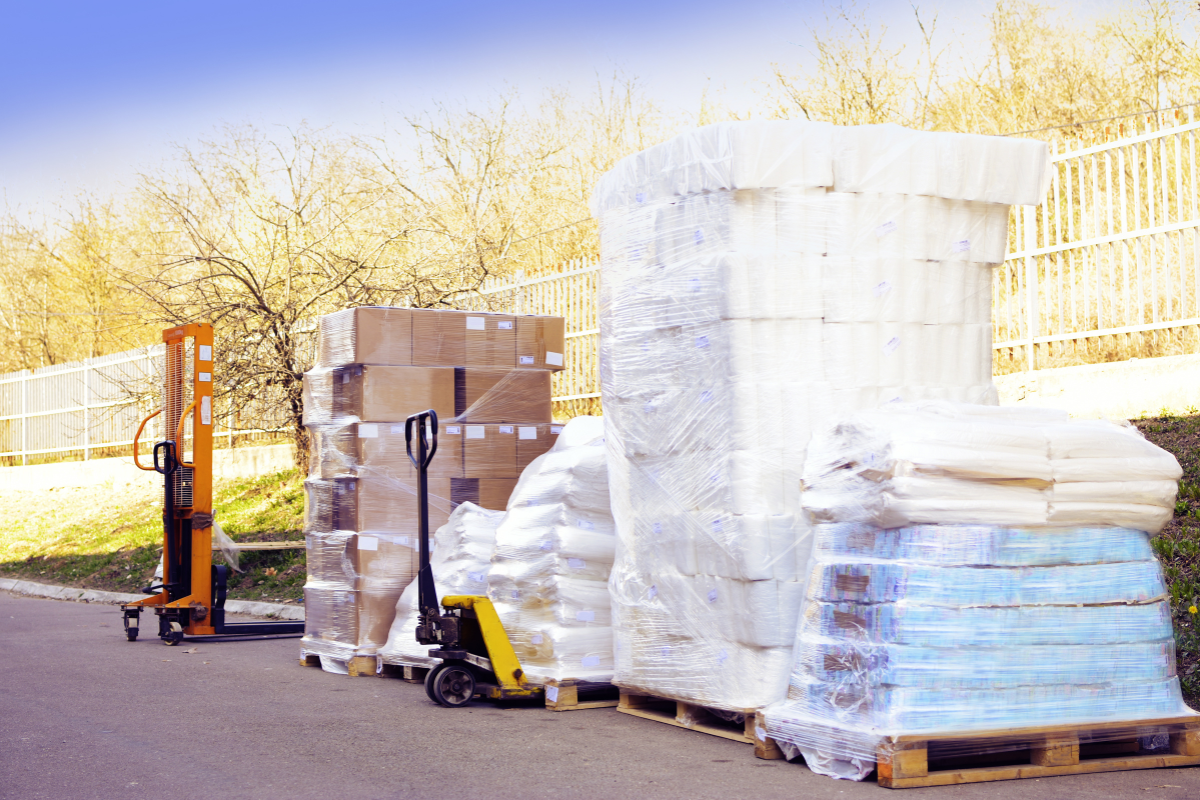
Plastic pallet wrap is one material that’s eligible for an exemption from the state’s extended producer responsibility for packaging program. | St.Marco/Shutterstock
The Product Stewardship Institute and the Oregon Department of Environmental Quality explained the different exemptions available to producers under the state’s incoming extended producer responsibility for packaging law in a recent webinar.
The Feb. 4 webinar covered the material-specific 869(13) exemption, which is intended to exempt products that don’t impose program costs on the producer responsibility organization because they are recycled outside of the commingled system.
To get the exemption, a producer must demonstrate that a material is collected through an outside recycling collection service, doesn’t undergo separation from other materials at a MRF and is recycled at a responsible end market.
There are three kinds of claims: passive, limited-active and active. An active claim is for any material that is eligible under the exemption and requires full substantiation. Passive claims are for two kinds of material, non-consumer tertiary or transport OCC and HDPE/LDPE pallet wrap. Limited active claims are for shredded printer or copier paper.
Justin Gast, a natural resource specialist with Oregon DEQ, noted that for those three materials – non-consumer tertiary or transport OCC, HDPE/LDPE pallet wrap and shredded paper – producers can also choose to request claims via a “pool volume.”
“That means instead of needing to substantiate that all qualifying criteria are met for a particular volume of materials, producers will have the option of being allocated a proportion of what we are calling a pool volume,” Gast said. “This is the volume of the material that has been reported in the material recovery survey as being recycled outside the commingled system.”
Those three materials are eligible for the simplified pool volume process because they represent the highest volumes outside of the commingled system and the state has solid data on their volumes recycled outside of the commingled system, courtesy of the material recovery survey.
Gast noted that for a passive claim, producers won’t have to submit a DEQ claim or demonstrate eligibility. For a limited active claim, producers will have to submit a form but will not have to demonstrate eligibility.
Active claims require producers to both submit a form and demonstrate eligibility.
No claim paperwork is required for a passive pool volume claim because those producers will simply report their gross supply rate in pounds of OCC and pallet wrap to Circular Action Alliance, the state producer responsibility organization, as part of their regular supply reporting.
CAA will then allocate the pool volume across all reporting producers based on the amounts reported.
For shredded paper, producers will need to fill out minimal parts of the claims form because CAA does not have a reporting category particular to printing and copying paper, Gast added.
The preliminary pool volumes are 228,175 tons for OCC, 7,936 tons for pallet wrap and 9,916 tons for shredded paper. Gast noted those amounts may change before May 1, and they could drop lower if any end markets currently receiving the material don’t self-certify as a responsible end market.
The pool volume for shredded paper could increase, he added, because only eight private shredding companies responded to the survey, and “DEQ knows there are other existing document destruction companies operating in Oregon.”
The current data is from Access Document Management, Docutrak, Graf Paper Salvage, Iron Mountain, Isecure Inc, Northstar Recycling, Paper Chase Recycling and Shred-It.
Other private shredding companies or service producers that offer separate document destruction services but combined the volumes with other fiber volumes reported when reporting have until March 6 to submit substantiation to the state, Gast said.
Submitting a claim form
There is an online claim submission portal that Jessica Branom-Zwick, director and partner at Cascadia Consulting, helped develop.
The form has eight main sections, six involving data entry. Branom-Zwick said the form is color-coded for user ease, and will also flag potential data entry errors.
There are two types of full active claims, one for producers who arrange for recycling and one for producers who don’t. Those who do not arrange for it themselves have to fill out more information, she said.
All active exemption claims are due by March 7, and DEQ will provide CAA with its claims determination on May 1. CAA will hold a drop-in session on February 25 for producers seeking support in submitting claims.
Nicole Portley, EPR program plan lead at Oregon DEQ, acknowledged the short timeline. DEQ originally planned to apply the exemptions in 2026 as a retroactive correction to 2025 fees but heard from producers that they wanted real-time fees.
“I want to acknowledge the complexity of what the statute is asking producers for,” she said. She added that DEQ is “balancing some competing needs here.”
“Producers want fairness, with the fairest possible approach being that every producer make a fully substantiated claim against the three criteria, but producers also want ease in terms of the process for claiming these exemptions,” Portley said. “And CAA and DEQ need an efficient process for considering and granting the claims.”
That’s why the state decided to simplify the process for the three selected materials, she said: “We recognize the statute is setting a high bar here for producer substantiation.”

